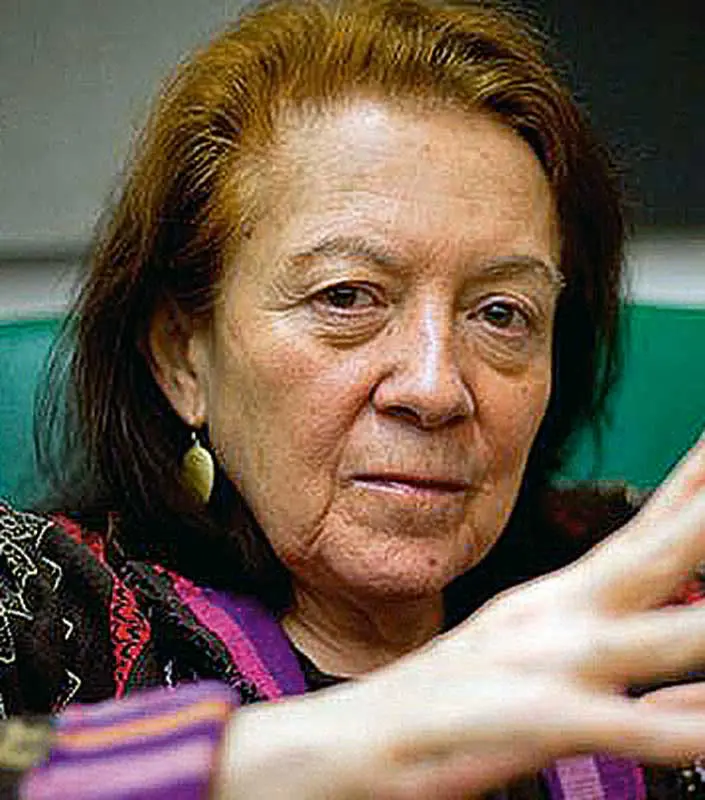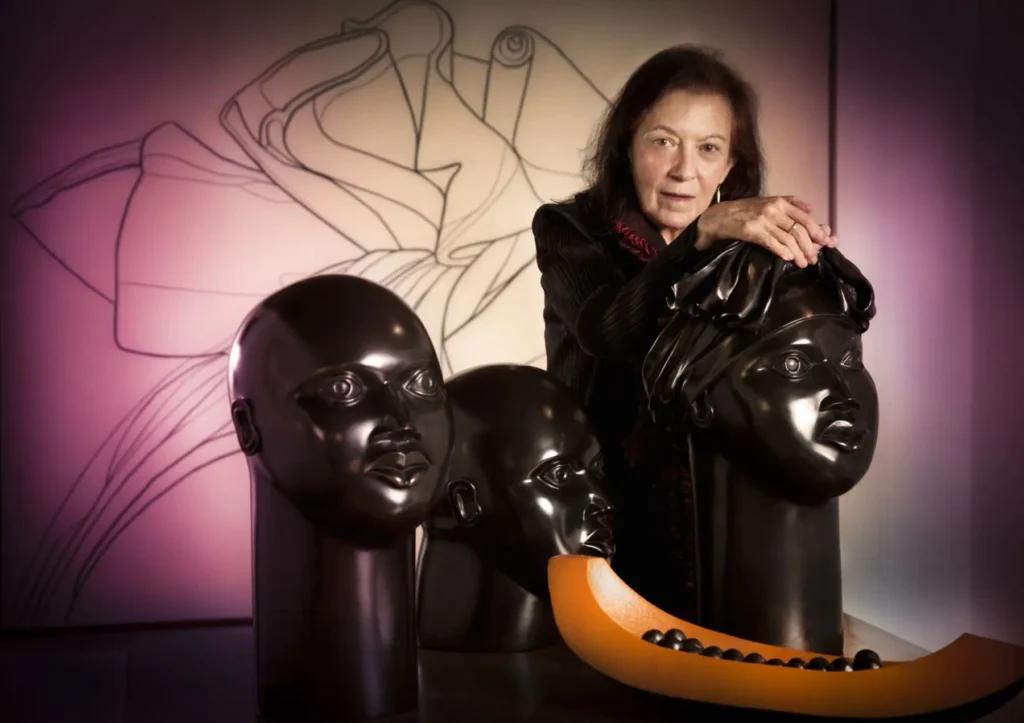
Ana Mercedes Hoyos was a Colombian painter and sculptor known for her colorful and lively depictions of Afro-Colombian culture. Through her art, Hoyos captured both the richness and hardship of life for black communities in Colombia’s Caribbean coast.

Some key points about Ana Mercedes Hoyos:
- Colombian painter and sculptor who achieved fame for her artworks depicting Afro-Colombian culture and folklore. She is considered one of the most important Latin American artists of the 20th century.
- Born in 1942 in Barranquilla, Colombia. She grew up in an upper class family but was exposed from a young age to the city’s vibrant mix of European, Indigenous, and African cultures.
- Hoyos began studying art as a teenager, showing an early talent for drawing and painting. She later attended the Fine Arts University in Bogotá.
- Her breakout work was a series of paintings of Afro-Colombian women titled Las Palenqueras, completed in the 1960s. These colorful portraits introduced her unique, lively style.
- Hoyos traveled extensively throughout Colombia’s Caribbean coast region, interacting with local black communities. She incorporated their stories, traditions, struggles, and resilience into her artworks.
- Major themes in her work include: scenes of daily life in Palenque and other costeño towns; Afro-Colombian folklore and traditional dances like the cumbia; powerful, hard-working Palenquera women; the vibrancy but also poverty of costeño culture.
- Her style combines modern techniques like cubism with the bright colors and sensuality of Latin American art. She often portrayed abstracted, faceless human forms.
- In addition to paintings and drawings, Hoyos was an acclaimed sculptor. Many of her bronze sculptures depict the strong bodies of black men and women.
- Hoyos achieved great success during her lifetime, with exhibitions across Latin America, Europe, and the United States. She received numerous honors and awards for her art.
- She died in Buenaventura, Colombia in 1984 at the age of 42. Her legacy lives on through her visually stunning, socially conscious artworks. She is hailed as giving voice and dignity to Afro-Colombian peoples.
Early Life and Education

Ana Mercedes Hoyos Mejía was born on October 27, 1942 in the colorful port city of Barranquilla, Colombia. Her father Ignacio Hoyos Castañeda was an engineer, while her mother Mercedes Mejía Amador was a homemaker. Hoyos grew up in a prosperous upper middle class family, the oldest of four daughters.
From a young age, Hoyos demonstrated an artistic inclination and talent for drawing and painting. She was particularly fascinated by the sights and sounds of downtown Barranquilla near her home. Here she observed the lively mix of Indigenous, African, and European peoples who gave the city its unique energy and identity.
As a teenager Hoyos began studying formally with the Cuban painter Félix Armando Núñez. Recognizing her promise, he encouraged the young artist to apply to prestigious art schools. Hoyos moved to Bogotá at the age of 16 to attend the Fine Arts University there.
Hoyos initially focused her studies on drawing and portraiture. She honed her technical skills under instructors that included the renowned Colombian artists Ignacio Gómez Jaramillo, Santiago Martínez Delgado, and Alejandro Obregón. Their modern styles combining cubism and surrealism with Latin American motifs would influence the development of Hoyos’ own aesthetic.
Early Artistic Career
After graduating from university in 1962, Hoyos began establishing herself professionally in Bogotá’s thriving arts scene. That same year she held her first solo exhibition at the gallery Teorema, showing expressionist figure drawings and oil paintings.
It was also around this time that Hoyos first traveled around Colombia, visiting cities along the Caribbean coast. On this trip she interacted extensively with local black populations, becoming engrossed in their stories, traditions, and struggles.
Hoyos started incorporating Afro-Colombian themes into her work, a subject that would come to define her art. Her breakout series was a set of figure paintings titled Las Palenqueras, completed in the mid-1960s.
- Las Palenqueras depicted the iconic women fruit sellers of Palenque, an historic community founded by escaped slaves.
- Hoyos portrayed the women balancing baskets of fruit on their heads in her signature colorful, lively style.
- With these vibrant portraits she introduced the beauty and grace of Palenqueras and costeño culture to wider audiences.
In 1967 Hoyos held her first major solo exhibition at the Biblioteca Luis Ángel Arango in Bogotá. She displayed Las Palenqueras along with drawings and other early paintings. The show was a great success, launching the 25-year-old Hoyos as an important emerging artist.
Key early works:
- Las Palenqueras (mid 1960s)
- Figures Dancing (1965)
- Women of the Coast (1967)
- Boy with Kerchief (1969)
Artistic Maturity and Wider Recognition
Over the next decade Ana Mercedes Hoyos continued to mature as an artist, refining her style and technique. She became increasingly interested in afrodescendiente themes, traveling extensively along Colombia’s Pacific coast to interact with black communities.
Hoyos absorbed their cultural traditions, folklore, daily struggles, and resilience. Her art provided a means of giving visibility and dignity to peoples historically marginalized in Colombian society.
Some important series and works from this key period in Hoyos’ career include:
- Marimba Players (1970) – Cubist drawings and paintings of musicians performing the traditional marimba costeña dance.
- Ancestral Legends (1972) – Surrealist interpretations of popular folk stories and myths from the Caribbean coast region.
- Women of the Fields (1975) – Depictions of female agricultural workers in vibrant dresses, shown bent over cultivation beds.
- Dance in the Tropics (1976-78) – A series capturing the energy and sensuality of dances like cumbia, fandango, and currulao.
- Bronze Figures (1977-79) – Abstracted, roughly textured bronze sculptures of both male and female black bodies in motion.
Hoyos continued exhibiting actively throughout Latin America, Europe, and the United States during the 1970s. Notable shows included the prestigious Biennale Internazionale dell ́Arte Contemporanea in Florence in 1972.
She received several honors during the decade including Colombia’s National Painting Award (1970) and the award for Best Foreign Artist at Brazil’s 31st São Paulo Art Biennial (1970).
Mature Style and Themes
By the late 1970s Ana Mercedes Hoyos had developed a mature and highly original style that blended varied artistic influences.
Some key features of her paintings, drawings, and sculptures from this period include:
- Vibrant, saturated colors reminiscent of Latin American Expressionism and Fauvism. She often used bright greens, yellows, oranges, blues, and reds.
- Sensual, curving lines and forms, depicting the natural beauty of the human figure.
- Abstracted, distorted body shapes, faces, and backgrounds. Heads are often featureless or mask-like.
- Visual rhythms created through repetition of forms, patterns, and spatial relationships on the canvas.
- Active, dynamic compositions full of movement and energy.
- Thick, textured application of paint in dense layers or quick brushstrokes.
- Bronze sculptures with rough, impressionistic textures applied through chiseling and other techniques.
In terms of subject matter, some of Hoyos’ major themes included:
- Everyday scenes of life in Palenque, capturing the richness of costeño culture.
- Vibrant portraits of Palenquera women in traditional dress, shown carrying fruit or cooking.
- Afro-Colombian folkloric traditions, dance, and music – like cumbia, currulao, fandango.
- Mythology and stories from costeño oral folklore.
- The strength and grace of the black female body.
- Hard-working laborers in fields along the Caribbean coast.
- The beauty but also poverty and hardship experienced in marginalized afrodescendiente communities.
Promoting Afro-Colombian Culture
Ana Mercedes Hoyos used her art not just to reflect Afro-Colombian culture, but to actively promote it within the larger society.
She sought to increase the visibility of marginalized peoples and demonstrate the vibrancy of their cultural expressions. Hoyos’ lively depictions showed costeños as beautiful, strong, and deserving of dignity and rights.
Hoyos worked to organize various exhibitions spotlighting the culture of Colombian blacks:
- In 1977 she curated a show titled Identidad: Women of the Coast featuring works by herself, Humberto Jagua, and others.
- In 1981 she organized the major exhibition Herencia Africana (African Heritage) showcasing art, traditional crafts, music, and dance.
- She co-organized the 1982 exhibition La Cultura Negra en el Arte Colombiano (Black Culture in Colombian Art).
Through these shows and her art, Hoyos highlighted how integral Afro-descendants were to Colombian national identity. She brought costeño culture into elite fine arts circles that had largely excluded such perspectives.
Later Life and Death
Even as she achieved fame, Hoyos continued living simply, staying closely connected to the Afro-Colombian communities she depicted in her art. She moved to the Pacific port city of Buenaventura in the late 1970s, making it her permanent home.
Hoyos was diagnosed with lupus in the early 1980s, but continued her artistic work despite deteriorating health. She undertook her last major series of paintings, Fish and Bicycles, between 1982 and 1984. These vibrant works thematically united her major motifs of women, the natural world, and everyday labor.
Tragically, Ana Mercedes Hoyos passed away on January 25, 1984 at the age of 42. She died in Buenaventura, the adopted city she had celebrated through her art.
Though her life was cut short, Hoyos left behind an incredible artistic legacy. She was one of the foremost chroniclers of Afro-Colombian culture and a pioneer in portraying marginalized peoples through fine art.
Legacy and Impact
Ana Mercedes Hoyos is remembered today as one of the most important Latin American artists of the 20th century. She helped bring international attention to the richness of Afro-Colombian culture and heritage.
Some key aspects of Hoyos’ legacy include:
- Introducing afrodescendiente themes into elite art circles that had largely excluded such perspectives. Her art demonstrated the vitality and grace of marginalized peoples.
- Inspiring future generations of Afro-Colombian and Latin American artists to explore their heritage in their work.
- Bringing unprecedented visibility and appreciation for Colombian popular cultures like cumbia that were looked down upon by elites.
- Highlighting the unique mixed heritage of Colombia’s Caribbean coast through her vibrant, lively style combining varied influences.
- Combating racial prejudice and asserting the dignity of marginalized groups through her positive, beautiful portrayals of black peoples.
- Producing a remarkably prolific body of work in just over 20 years as an artist, creating hundreds of paintings, drawings, and sculptures.
- Achieving great mainstream success as both a commercial artist and winning prestigious institutional honors like Colombia’s National Painting Award.
Decades after her death, Ana Mercedes Hoyos’ art continues to be appreciated around the world. Major retrospectives of her work have traveled globally, introducing new audiences to Hoyos’ unique visual language.
Her paintings, drawings, and bronzes capturing the spirit of the Colombian Caribe now sell for tens of thousands of dollars at auction. Hoyos’ legacy as an artist who gave voice and dignity to the Afro-descended peoples she portrayed remains stronger than ever.
Notable Artworks and Series
Throughout her short but influential career, Ana Mercedes Hoyos created hundreds of paintings, drawings, prints, and sculptures. Some of her most iconic and important works include:
Las Palenqueras
- Date: Mid 1960s
- Medium: Oil paintings
- Subject: Afro-Colombian women fruit sellers of Palenque
This colorful, lively series of portraits introduced Hoyos’ unique style and established her as an important new artist on the Colombian art scene.
Women of the Fields
- Date: 1975
- Medium: Acrylic paintings
- Subject: Female agricultural workers bent over rows of cultivation.
Vibrant images highlighting the grace and diligence of rural laborers while also hinting at their economic hardship.
Dance in the Tropics
- Date: 1976-1978
- Medium: Oil paintings, charcoal drawings
- Subject: Sensual scenes of dances like cumbia, fandango, currulao.
Energetic works that distill the essence of traditional Afro-Caribbean folkloric arts.
Bronze Figures
- Date: 1977-1979
- Medium: Bronze sculpture
- Subject: Abstracted figural forms in motion.
Roughly textured, fragmented bronzes exploring the human body and movement in an avant garde way.
Fish and Bicycles
- Date: 1982-1984
- Medium: Mixed media paintings
- Subject: Women riding bicycles, carrying fish, in vivid colors.
Hoyos’ final series uniting her major motifs of femininity, labor, and the vibrancy of the natural landscape.
Historical and Artistic Influences
Ana Mercedes Hoyos’ unique visual language was shaped by diverse influences from art history and Colombian culture:
- Fauvism – The early 20th century modern art movement that used non-naturalistic, vivid colors. Hoyos adopted a similarly bold, saturated palette.
- Cubism – Hoyos integrated cubism’s fragmented planes, geometric forms, and multiple perspectives into her compositions.
- Latin American Expressionism – Like Orozco and other expressionists, Hoyos simplified forms and deployed energetic brushstrokes and colors.
- Costeño folk arts -The dynamic rhythms of the cumbia informed her work. She integrated traditional crafts materials like clay.
- Afro-Cuban themes – Having studied under a Cuban painter, Hoyos was inspired by Cuban portrayals of santería rites and afrocubanismo culture.
- Colombian masters – Teachers like Obregón instilled in Hoyos a distinctly Colombian visual language blending European modernism with local subjects.
- Pre-Columbian art – Ancient indigenous statuary and pottery’s simplified, abstracted forms impacted her figural sculptures and paintings.
By synthesizing such diverse influences, Hoyos forged a one-of-a-kind style that gave visual form to the hybrid culture of Colombia’s Caribbean coast.
Auction Prices and Notable Sales
As one of the most acclaimed Latin American artists of the 20th century, Ana Mercedes Hoyos’ works have become highly coveted by collectors and institutions.
Major international auction houses like Sotheby’s and Christie’s have sold her paintings and sculptures for tens of thousands of dollars. Some notable auction records and sales include:
- In 2012, Hoyos’ painting La Siembra sold at Christie’s London for £60,000 (US $95,000).
- A 1977 bronze sculpture Torso achieved $92,500 at Sotheby’s New York in 2008.
- Mi Familia, a 1973 painting depicting a family in vibrant hues, sold for $92,000 at Christie’s in 2005.
- Hoyos’ 1983 painting Los Pescos was purchased directly from the artist by Colombia’s Banco de la República museum for $80,000.
- Works on paper like lithographs and etchings sell for lower prices in the $5,000-$15,000 range at auction.
These high sales figures attest to Hoyos’ prestige and the timeless appeal of her singular visual creations depicting Afro-Colombian heritage. Her market value continues to grow as museums and collectors seek to add her works to their collections.
Conclusion
In just over twenty years as an artist, Ana Mercedes Hoyos created an incredible and deeply meaningful body of artwork that captured the spirit of Colombia’s marginalized peoples. She overcame prejudice and exclusion to place the grace and richness of Afro-Caribbean traditions within elite fine art circles.
Hoyos’ lively paintings, drawings, and sculptures stand as a testament both to the hardships and resilience of communities like Palenque. Her innovative style bridged European and Latin American modernism with the vibrant local cultures of Colombia’s coast.
The artist’s early death at 42 was a tragedy that cut short a career at its height. Yet Hoyos’ legacy continues to inspire admiration in all who encounter her joyful, colorful depictions of afrodescendiente life. She remains one of the 20th century’s most original artistic chroniclers of the human experience.






